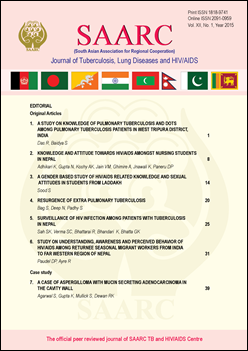Surveillance of HIV Infection among Patients with Tuberculosis in Nepal
DOI:
https://doi.org/10.3126/saarctb.v12i1.15939Keywords:
HIV clients, TB/HIV Co-infection, Pulmonary and Extra Pulmonary TB, ART, PITCAbstract
Introduction: Tuberculosis is one of the most prevalent infectious disease and significant public health problem in Nepal. The importance of HIV surveillance among tuberculosis (TB) patients is increasingly being recognized as the HIV epidemic continues to fuel the global TB epidemic. In many countries the HIV prevalence in TB patients is a sensitive indicator of the spread of HIV into the general population. The aim of this study is to find out the HIV epidemic among TB patients.
Methodology: This was a periodic sentinel survey, i.e. cross-sectional HIV Sero-prevalence survey of all newly registered TB cases above 15 year old to provide point estimate. This survey was carried out in six major diagnostic centres of tuberculosis of Nepal from July 2012 to February 2013. The calculated sample size for the surveillance study was 1000. The findings were processed/analyzed using SPSS (version 16) computer software. Descriptive statistics was used to observe the pattern in each variable.
Results: The study revealed that four-fifth (80.9%) TB patients investigated were pulmonary positive and one-fifth (19.1%) extra pulmonary. Prevalence of HIV among tested TB patients was 2.4% and prevalence was comparatively more (2.8%) in Male than Female (1.4%). Sentinel site wise prevalence of HIV was higher (6.7%) in United Mission to Nepal (UMN), Palpa followed by 3.1%, 2.9% and 2.7% in District Public Health Office (DPHO), Kanchanpur, International Nepal Fellowship (INF), Nepalgunj and Regional tuberculosis Centre (RTC), Pokhara respectively. Comparatively prevalence was low (1.3%) in National Tuberculosis Centre (NTC), Thimi and not a single case of HIV among tested TB patients was found in Nepal Anti-TB Association (NATA), Biratnagar. Significant proportion (7.8%) of HIV prevalence was found in the age group of 35-39 years followed by 4.6%, 3.6% and 2.8% among the age group of 40-44 years, 50-54 years and 30-34 years age group respectively.
Conclusion: Among all TB/HIV co-infected, significant proportion is found in 35-39 years and lowest in 20-24 age groups. Therefore, it is important to implement targeted interventions in the age group between 30-55 years age group. Provider Initiated Testing and Counseling (PITC) in TB clinical setting plays important role to enroll more TB patients for HIV test.
SAARC J TUBER LUNG DIS HIV/AIDS, 2015; 12(1), Page: 25-30
Downloads
Downloads
Published
How to Cite
Issue
Section
License
Copyright © SAARC Tuberculosis and HIV/AIDS Centre (STAC), all rights reserved, no part of this publication may be reproduced, stored in a retrieval system or transmitted in any form or by any means without prior permission of the STAC.




